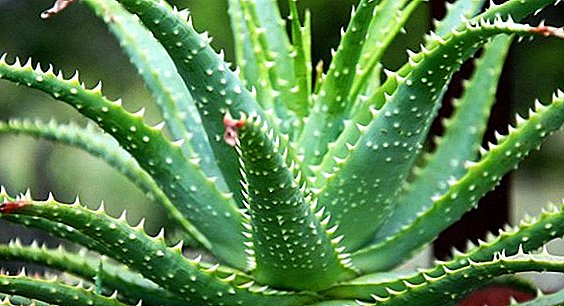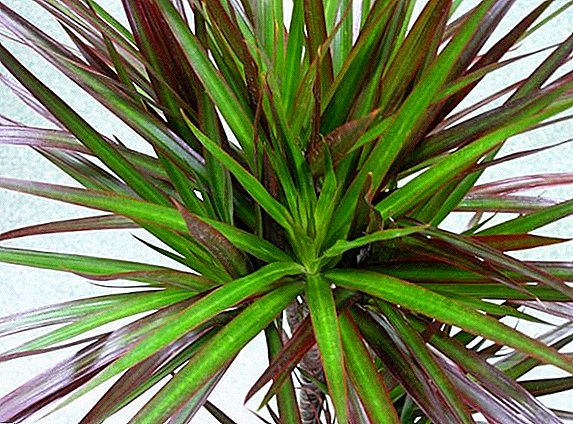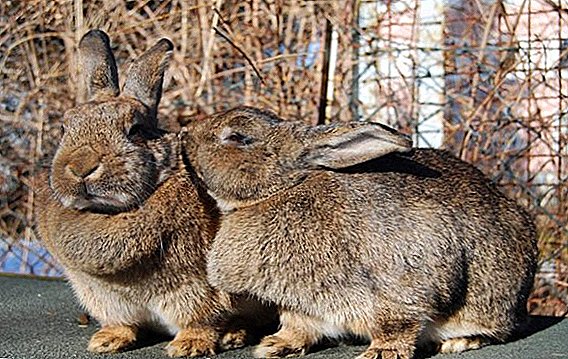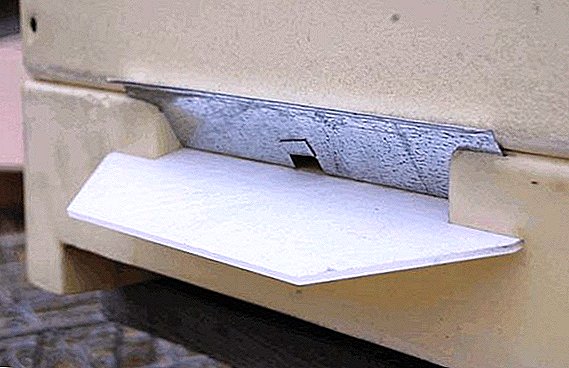 Vital activity of bee colonies depends on the number, shape and size of the hives in the hives. First of all it concerns air ventilation, drafts and wintering of insects. What should be the ideal entrance to the hive, how to build the hole yourself and how many they need for an active honey collection - we will tell about all this later in the article.
Vital activity of bee colonies depends on the number, shape and size of the hives in the hives. First of all it concerns air ventilation, drafts and wintering of insects. What should be the ideal entrance to the hive, how to build the hole yourself and how many they need for an active honey collection - we will tell about all this later in the article.
What is letke?
At first glance, everything seems to be elementary: the entrance door acts as an entrance door to a bee house and in winter protects bees from the cold. But, if you go deeper, the functionality of this detail is much broader and more important. After all, it’s not for nothing that this topic has attracted the attention of beekeepers for years and was mentioned more than once in the pages of specialized literature.
Did you know? The average bee family has about 50 thousand insects.Therefore, before we talk about the types and methods of construction of this part of the hive, let us figure out what a letka is and why it is so important that in reality it meets all the requirements.
 In scientific sources on beekeeping, a hole in the evidence for entry and exit of bees is indicated by a lettuce. It affects the performance and productivity of tenants. For example, if the entrance is made too small, it will be difficult for the bees to sneak in and out.
In scientific sources on beekeeping, a hole in the evidence for entry and exit of bees is indicated by a lettuce. It affects the performance and productivity of tenants. For example, if the entrance is made too small, it will be difficult for the bees to sneak in and out.And given the fact that such an obstacle needs to be overcome several dozen times in a day, one can imagine how much time and physical resources will be wasted. But the worst thing is that in close "doors" of bees, hairs on legs quickly wear out and break off wings. In addition, they suffer from a lack of fresh air.
If you plan to expand your apiary, it will be useful for you to learn about the methods of breeding queen bees, reproduction of bees by layering, swarming and the stages of development of bee larvae.Clever insects will find a way out of the situation, but this is not the best effect on the amount of honey. As a result, a lot of precious time will be spent on ventilating the nest. From this design will be more harm than good.
Did you know? Bees have highly developed olfactory receptors. Per kilometer insect is able to smell the smell of a honey flower.Too big a hole in the hive for bees can lead to drafts, which is deadly for the family. Ideally, this detail should be such as to provide insects with good ventilation at any time of the year. During the hot season, the airing should be much more intense, but in winter the air flow should be reduced so that the hive is not cold and damp.
Main types
Since the moment when people mastered the subtleties of beekeeping and learned how to manage the processes of honey collection, a lot of summer species were tested. Testers made them square, round, rectangular and even triangular, vertical, horizontal, narrow, wide, large and small, arranged holes at different heights of the hive, experimented with their number.
The search for the best notch that would meet the natural needs of insects and did not cause any trouble in the care was completed. Today experts share the upper and lower entrances to the bee's nest. Consider their features.
Important! It is not worth while to winter for too little warming of the bee cell - bee families during the wintering period emit a large amount of carbon dioxide accumulating in the walls of their home. Excessive insulation will interfere with air circulation and weathering of vapors. As a result, mold and tsvel on the walls of the hive.
Lower
As a rule, they are equipped at the level of a flight board for bees, which is attached to the bottom of a bee house. Despite the fact that beekeepers often call the hole "trash", it is the most important because it skips the bulk of pollen and nectar. Also through this entrance, insects remove trash and deceased counterparts. 
Ideally, the size of the lower years must meet the standards: 200 x 10 mm. But in multi-case evidence they are made across the entire width of the bottom. In amateur apiaries, you can often see the inventive approaches of beekeepers to the construction of letkov. Some make them in several pieces, citing such a decision with climatic features and beekeeping techniques.
Experts talk about the need to maintain a comfortable size for the entrance and exit of bees and the obligatory presence of a flight board. It provides insects with a comfortable landing, and also plays the role of a landing pad during the main bribe period.
In those houses where there is no flight board, overloaded by bees often fall, which affects the pace and productivity of the family’s work. Therefore, it is an integral part of any hive. And to facilitate the landing, experts advise to set the inclined planks to the ground.
Did you know? A bee is able to carry a load that exceeds its weight by a factor of twenty.
Upper
This species of bee caps can vary in size and shape. Usually in summer the length of the hole is adjustable in manual mode with the help of the letke barber, and for the winter it is completely closed. It is easy to make latches at home from scrap materials: plastic, wood, dense metal grill. 
It is unacceptable that in the cold season were open upper and lower yole. The period from the beginning of wintering of bees to the first February weeks is especially dangerous. But in the future insects require much more fresh air. This happens in connection with the laying of eggs. Therefore, it is important to slightly open the top ventilation cover. Ensure that the temperature regime inside the evidence is not lower than 4 degrees Celsius.
Modern beekeepers prefer to make the upper openings round (diameter up to 2.5 cm) and longitudinal slit-like (1.2 x 1 cm in size). Experts note the positive qualities of both forms, and also emphasize the best security of the latter option against thieving bees.
It is recommended to install such entrances at a distance of 5 cm from the upper edge of the evidence. But on the half-frames in the shop stands, tap-holes are not needed.
Important! The process of collecting honey is influenced not only by the size and shape of the hives in the hives. It also makes sense to consider their direction. According to experienced beekeepers, the best option is the north side, because insects like to build honeycombs along the Earth’s magnetic field. It is important to pay attention to the climatic features of the area. That is, in cold regions, it is advisable to turn troughs to the southeast, and in hot regions, the northeast vector will ideally suit.
Basic requirements for the entrance
Regardless of the type of hives, all gaps must meet certain functional standards. Their main mission is to:
- ensuring the unhindered connection of honey insects with the outside world and the return access to the home;
- reliable protection from predators, rodents and other pests, therefore, when installing holes, it is necessary to exclude similar penetrations into the hive;
- regulated bee house ventilation and natural ventilation;
- ensuring forced ventilation of the nest, if necessary;
- a short delay in arriving with a bribe and outgoing bees;
- the possibility of quick and comfortable cleaning of the hive debris;
- good visibility against the front of the bee house (it is important that the bees, especially the uterus, do not wander in search of entry and exit);
- opportunities to harmonize the limits of the notch with the potential of the bee family.
Honey is not the only bee product that is popular. Beeswax, propolis, zabrus, perga, royal jelly and bee venom are also widely used.
In addition, all tap-holes should be equipped with a summer barrier. They are needed to control the passages, as well as to close the hole when transporting hives to more cereal honey plants.
Important! The presence of correct letkov in the hives does not mean that their residents are provided with comfortable conditions. It is important to correctly use the regulators and valves. For example, if in the summer you saw a "beard" of insects on the flight board, it means that it is hot inside their home. It is necessary to open all the branches at full strength. And if the spring does not close the lower gage in the hives with weak bee colonies, thief insects will plunder the whole nest.
How to make a hole with your own hands
If you have already mastered the basics of the functioning of bees in the family and know how to care for them, then building a letka at home will not cause you much trouble. The main thing is to determine its form and stock up on the necessary drawings.
We recommend that you familiarize yourself with the functions of bees and drones in the family.
Round
Round letkovy forms in diameter should not exceed 2 cm. For their construction does not require any additional installations. They are drilled with large drills with an appropriate diameter. And after that, in manual mode, it is expanded and cleaned with sandpaper.
The edges of such "doors" should be very smooth, so that insects are not damaged. On them, according to the principle of the heck, a larger diameter valve is attached. In the hot season, the bolt opens, and in winter tightly closed. 
Square
This form of letkov modern beekeepers prefer very rarely, and often it happens in the southern regions. The beekeeper chooses the size of the hole at his discretion, guided by the power of the bee family and the climatic conditions. Standard option offers square on the sides of 2.5 cm. The entrance is made on the principle of the previous drill, then the corners are manually sharpened and the sides are polished.
Did you know? Scientists have calculated that for the entire period of honey collection, one bee overcomes the path equal to the cosmic distance from the Earth to the Moon.
Rectangular
This beekeeper is also preferred by the beekeepers of the southern regions. Its distinctive features are in the improved ventilation of the hive. Place the similar parts both above and below.
To build a rectangular notch, draw a hole drawing, which is about 6-7 cm long, and the width does not exceed 1 cm. This scheme is suitable only for the upper structures, and the lower ones, according to beekeeping standards, must fit 200 x 10 mm. To create this form, the entrance will need only a sharp nail file on the tree. She cut out the desired shape, then sandpaper carefully mend the edges. 
Triangular
According to the beekeepers who practice the triangular holes, they resemble in their form the natural annals that the bees themselves arrange on the trees. Those who want to bring their apiary as close as possible to natural conditions prefer triangles.
Different sources on beekeeping offer options with the underside of a figure of 3-4 cm and hips of 1-2 cm. The choice should be based on the peculiarities of the climatic latitudes of a particular region.
Did you know? The bee has five eyes, and conveys information to its brethren through specific dances.A hole is also made using a saw on the preliminary drawing. It is important that there are no irregularities at the edges of the entrance. The latch is fastened with screws, and in size it slightly exceeds the "door".
Full width
These tap holes are designed for abundant ventilation of hives at any time of the year. Since it is impossible to control the temperature regime in winter in bee dwellings with a similar entrance, it is intended only for warm edges. Also, tapes are practiced to the full width in multi-hull, so-called Dadanov hives. Often they are located at the bottom. 
The advantage of this solution is the convenience in the work of insects and comfortable conditions in the heat. Its complexity lies in the construction. To do this, you will need special wood blanks on the bottom, drill, saw, gate valve, nails or dowels and small screws.
First of all, it is necessary to assemble the bottom frame from 6 wooden boards. Then a plywood sheet cut to size is laid on it and fastened with 3 additional bars on top. Note that the durability of such a structure does not exceed three seasons, since the material is prone to soaking. On the resulting structure is put the first hive tier. Above is provided a similar structure.
Important! For humans, the bites of hundreds of bees are deadly.
Gate valve
All tap holes must necessarily be equipped with special barriers. They are made of wood, plastic, as well as galvanized elements, equipped with small cuts for the passage of honey insects. Externally, these are small plates, one of which provides cutouts and moves freely.
Shop copies are often equipped with perforated grilles, which provide ventilation, but do not allow the exit of bees. Valves of various sizes and shapes are commercially available, so you can find suitable variations for your hives in the assortment. A similar fixture is fastened to the wall of a bee house with a screw or a self-tapping screw (this is done through the central hole). 
In some species, turning the valve can adjust the position of the notch. The role of this design is very large. It helps the family to develop, to work productively and to successfully endure climatic vagaries in the autumn-winter period. The valve also protects bees from birds and other unwanted guests of the hive. But, unfortunately, not all factory copies receive good reviews from practicing beekeepers, so some of them resort to homemade variations.
Learn how to make a hive with your own hands (Alpine, Nucleus, Warre), wax refinery and honey extractor.At home, the manufacture of the valve for a beehive is based on the principle of interaction between two parallel parts, a profile and a lid. To do this, you need to stock up with a thin tin plate. From her scissors cut the shape of the notch in slightly larger sizes.
One of the edges must be bent up to 180 degrees to form a guide panel. After that, the profile is installed on the arrival board and fixed to the evidence with screws or studs. This is a primitive, but a great option for old bee houses.
Did you know? Of all the existing representatives of the bee family, the most dangerous is the African species, which, at the slightest danger, attacks with a whole swarm. For this, she received the nickname of the killer bee. The fact went down in history as in 1969 about 200 Brazilians died from the bites of these insects. A few thousand more people remained alive, but they were badly hit by bites.Obviously, the bee entry is far from a secondary device in the hive. Now you know what it is for, what it should be and how to protect the bee from loss.












